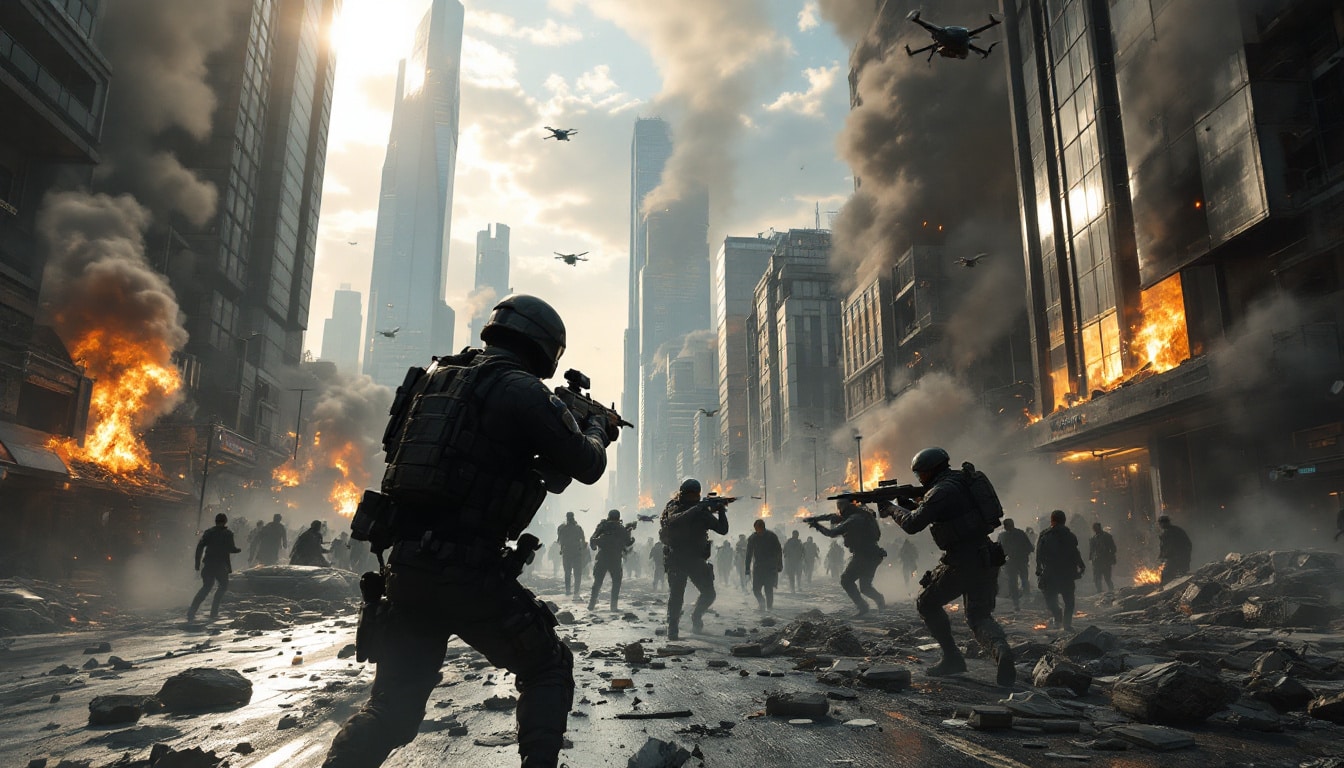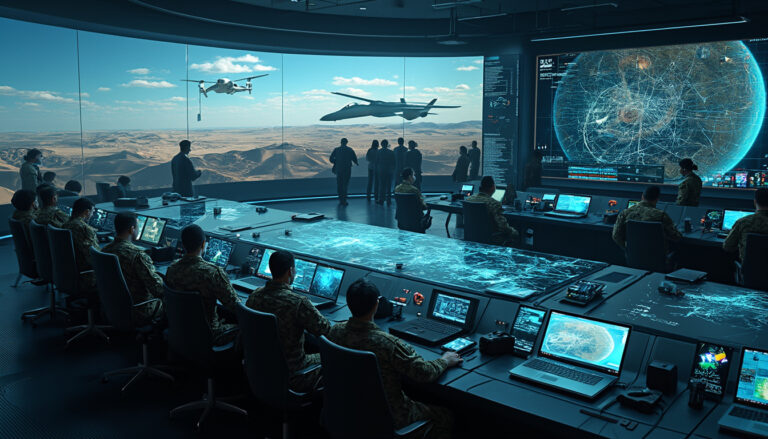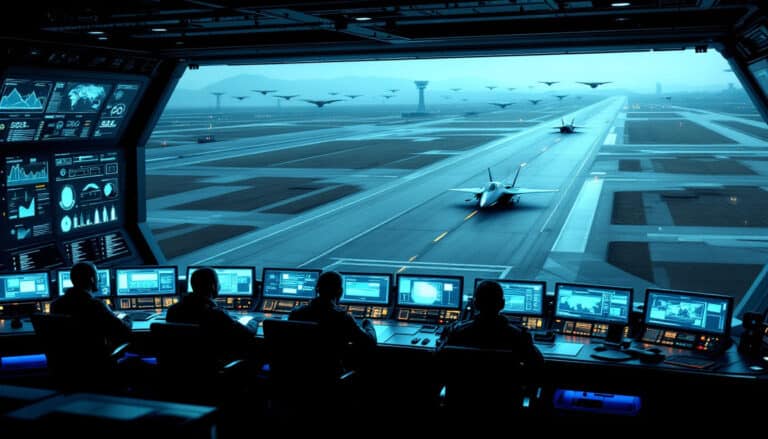The fascinating intersection between technology and urbanism shapes a new horizon for the armed forces.
With the emergence of megacities, the dynamics of conflicts are transfigured, heralding unprecedented challenges.
This phenomenon is characterized by faster information exchanges and constant innovations.
Recent transformations urge a reconsideration of the distinction between civilian and military spheres, raising questions about national security. Technological issues lead to developments in military capabilities, especially in the face of emerging threats. Research conducted by armasuisse Science and Technology (W+T) significantly sheds light on these developments. By focusing on anticipating potential dangers, this work helps better understand the impacts of civilian innovations on the military framework, particularly regarding planning and military force development.

Table des matières
ToggleWhat are the challenges of urban warfare?
Urban areas today constitute a complex theater of operations for contemporary armies. Several major challenges arise when engaging in military operations within these densely populated environments. First and foremost, civilian protection becomes a top priority. Soldiers must navigate through civilian populations, making each strategic action delicate. The difficulty in distinguishing combatants from non-combatants further complicates the tactical decisions that need to be made.
Another fundamental aspect is the exploitation of urban infrastructures. Buildings, tunnels, and transport networks can be used by both military forces and opposing groups. Thus, controlling urban territory is not limited to occupying a physical space but also involves intelligent management of resources and communication pathways. Furthermore, urban warfare imposes upon military personnel the need to adopt advanced technologies for surveillance, data analysis, and targeted interventions. Tools such as drones and real-time intelligence systems become indispensable for understanding the situation on the ground.
Logistics also presents a challenge. Supply lines are often strained in an urban context due to congestion and physical obstacles. Armies must therefore plan alternative methods to deliver vital resources to engaged troops. All these challenges necessitate a redefinition of military strategies, where a deep integration of information and technology is crucial.
How do megacities influence armed conflicts?
Megacities represent a modern battleground, where challenges have intensified. Due to their size and density, these cities lead to an amplification of security issues. For example, at a glance, one can observe how social tensions within an overcrowded city can escalate into open conflicts. Rapid urbanization, driven by economic and environmental factors, generates governance crises. In this context, armed forces must prepare for military confrontations in increasingly unstable environments.
Technological changes in the field of mobility and communications also play a role in this dynamic. Today’s urban conflicts no longer consist solely of direct military confrontations. They also encompass forms of cyber warfare and propaganda, where information can be manipulated to influence local or international public opinion. Thus, a modern army must possess not only traditional military capabilities but also skills in strategic communication.
Moreover, with the emergence of an increasing number of criminal networks in these megacities, the challenge faced by armed forces becomes even more complex. The decentralization of power, where non-state factions exert significant influence, requires a multidisciplinary approach to security.
What are the prevailing technological innovations in urban areas?
Technological advancements offer a multitude of new tools for military operations in urban settings. Drones are one of the main components of this technological revolution. Their ability to monitor large areas in real-time provides immense strategic value. Drones can also be used for targeted strikes, reducing the risk of civilian casualties while maximizing operational effectiveness.
Additionally, augmented reality and virtual reality are also making their way into the military sphere. These technologies allow training soldiers in simulated environments that closely resemble reality, thus best preparing troops for real-world interventions. Virtual simulations can accurately replicate the complexities of an urban neighborhood, helping soldiers better prepare for future engagements.
Intelligence systems based on artificial intelligence are also becoming predominant. By analyzing large amounts of data, these systems help armed forces identify potential threats before they manifest. Predictive analytics capabilities developed through AI contribute to informing decisions on the ground, making military operations in urban settings more effective and safer.
The integration of communication technologies, such as mesh networks, is also essential. These systems allow forces to remain connected even in areas where digital infrastructures are failing. Thus, throughout operations, the flow of information remains constant, optimizing responses to unforeseen events.
What are the impacts of urban conflicts on infrastructures?
Military operations in urban settings have deep repercussions on infrastructures. Critical infrastructures, such as water, electricity, and transport networks, often become strategic targets. This can lead to disastrous consequences for the civilian population, rendering the operations not only military but also humanitarian.
The impact on reconstruction is also a central issue. Following conflicts, cities must rebuild. This requires careful planning of infrastructures to ensure they are resilient to future instabilities. Even before the fighting ends, engineering and logistics teams must assess the damage and begin implementing appropriate solutions.
Moreover, during conflicts, the lack of access to basic services, such as drinking water and electricity, can lead to epidemics and health crises, thereby exacerbating the suffering of surrounding populations. Armed forces must therefore develop strategies to minimize these impacts and protect critical infrastructures as much as possible.
One element to consider is also the multinational approach that can prove essential during reconstruction phases. Partnerships between governments and non-governmental organizations in reconstruction can play a fundamental role in restoring infrastructures while effectively addressing the needs of affected populations.
How does international law regulate urban warfare?
The international context of armed conflicts is governed by a set of conventions and laws that regulate military operations, particularly in urban settings. International humanitarian law states that parties to the conflict must distinguish between military objectives and civilians, thereby minimizing retaliation and collateral damage.
Urban conflicts raise moral and legal questions: how far can military forces go to achieve their objectives without harming civilians? Airstrikes and remote strikes are often criticized for their devastating impact on local populations. Thus, military commanders face the necessity to comply with human rights regulations while pursuing operational objectives.
The importance of the Geneva Conventions is emphasized more than ever in this context. In the event of non-compliance with these conventions, military actors may face international prosecution for war crimes. This creates an even more complex framework for tactical decisions, as the consequences affect the reputation of nations and the acceptability of their actions on a global scale.
International law continues to evolve to adapt to the new realities of war. The rise of asymmetric warfare and the involvement of non-state actors make the enforcement of these laws even more challenging. The international community must therefore face the necessity of strengthening regulations while educating the forces involved on the importance of humanitarian conduct in wartime.
What roles do discussions on urbanity play in the future of military strategies?
Reflections on urbanity are increasingly present in contemporary strategic debates. Conferences, forums, and academic publications regularly address these themes, analyzing how military forces can better prepare for the realities of operations in urban settings. For instance, the research program “Technology Foresight” illustrates how technological advancements and social changes influence future military capabilities.
Urban interventions require a thorough understanding of social dynamics. Consequently, armies must integrate social science specialists to develop strategies better suited to specific contexts. This shift is crucial to ensure an approach that harmonizes military missions with the needs of civilians.
The issues of communication and community engagement are also at the heart of these discussions. The way military personnel interact with the various constituents of a city can impact the outcome of operations. Approaches that promote dialogue and community engagement help to reduce tensions and foster a peaceful environment.
In summary, urban issues must be integrated into future military doctrines to ensure that armed forces are prepared to face these challenges. Innovations, both technological and sociological, play a determining role in this transition.
























